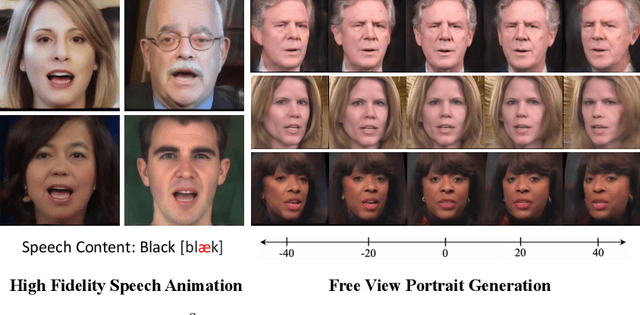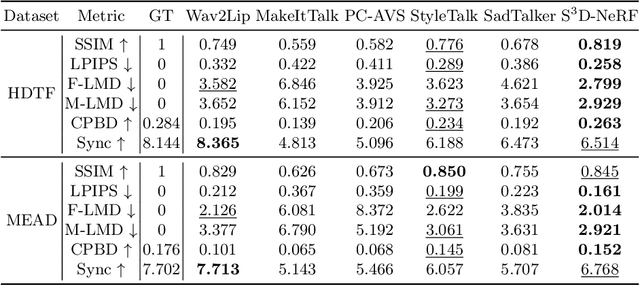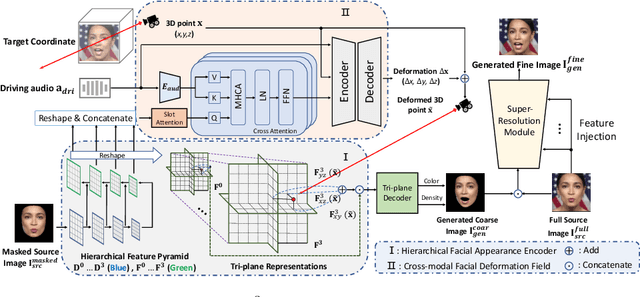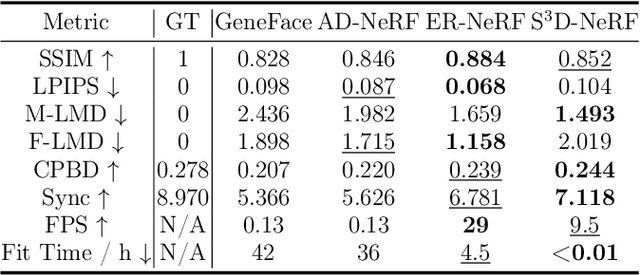Yifeng Ma
StyleTalk++: A Unified Framework for Controlling the Speaking Styles of Talking Heads
Sep 14, 2024



Abstract:Individuals have unique facial expression and head pose styles that reflect their personalized speaking styles. Existing one-shot talking head methods cannot capture such personalized characteristics and therefore fail to produce diverse speaking styles in the final videos. To address this challenge, we propose a one-shot style-controllable talking face generation method that can obtain speaking styles from reference speaking videos and drive the one-shot portrait to speak with the reference speaking styles and another piece of audio. Our method aims to synthesize the style-controllable coefficients of a 3D Morphable Model (3DMM), including facial expressions and head movements, in a unified framework. Specifically, the proposed framework first leverages a style encoder to extract the desired speaking styles from the reference videos and transform them into style codes. Then, the framework uses a style-aware decoder to synthesize the coefficients of 3DMM from the audio input and style codes. During decoding, our framework adopts a two-branch architecture, which generates the stylized facial expression coefficients and stylized head movement coefficients, respectively. After obtaining the coefficients of 3DMM, an image renderer renders the expression coefficients into a specific person's talking-head video. Extensive experiments demonstrate that our method generates visually authentic talking head videos with diverse speaking styles from only one portrait image and an audio clip.
S^3D-NeRF: Single-Shot Speech-Driven Neural Radiance Field for High Fidelity Talking Head Synthesis
Aug 18, 2024



Abstract:Talking head synthesis is a practical technique with wide applications. Current Neural Radiance Field (NeRF) based approaches have shown their superiority on driving one-shot talking heads with videos or signals regressed from audio. However, most of them failed to take the audio as driven information directly, unable to enjoy the flexibility and availability of speech. Since mapping audio signals to face deformation is non-trivial, we design a Single-Shot Speech-Driven Neural Radiance Field (S^3D-NeRF) method in this paper to tackle the following three difficulties: learning a representative appearance feature for each identity, modeling motion of different face regions with audio, and keeping the temporal consistency of the lip area. To this end, we introduce a Hierarchical Facial Appearance Encoder to learn multi-scale representations for catching the appearance of different speakers, and elaborate a Cross-modal Facial Deformation Field to perform speech animation according to the relationship between the audio signal and different face regions. Moreover, to enhance the temporal consistency of the important lip area, we introduce a lip-sync discriminator to penalize the out-of-sync audio-visual sequences. Extensive experiments have shown that our S^3D-NeRF surpasses previous arts on both video fidelity and audio-lip synchronization.
DreamTalk: When Expressive Talking Head Generation Meets Diffusion Probabilistic Models
Dec 15, 2023Abstract:Diffusion models have shown remarkable success in a variety of downstream generative tasks, yet remain under-explored in the important and challenging expressive talking head generation. In this work, we propose a DreamTalk framework to fulfill this gap, which employs meticulous design to unlock the potential of diffusion models in generating expressive talking heads. Specifically, DreamTalk consists of three crucial components: a denoising network, a style-aware lip expert, and a style predictor. The diffusion-based denoising network is able to consistently synthesize high-quality audio-driven face motions across diverse expressions. To enhance the expressiveness and accuracy of lip motions, we introduce a style-aware lip expert that can guide lip-sync while being mindful of the speaking styles. To eliminate the need for expression reference video or text, an extra diffusion-based style predictor is utilized to predict the target expression directly from the audio. By this means, DreamTalk can harness powerful diffusion models to generate expressive faces effectively and reduce the reliance on expensive style references. Experimental results demonstrate that DreamTalk is capable of generating photo-realistic talking faces with diverse speaking styles and achieving accurate lip motions, surpassing existing state-of-the-art counterparts.
TalkCLIP: Talking Head Generation with Text-Guided Expressive Speaking Styles
Apr 01, 2023Abstract:In order to produce facial-expression-specified talking head videos, previous audio-driven one-shot talking head methods need to use a reference video with a matching speaking style (i.e., facial expressions). However, finding videos with a desired style may not be easy, potentially restricting their application. In this work, we propose an expression-controllable one-shot talking head method, dubbed TalkCLIP, where the expression in a speech is specified by the natural language. This would significantly ease the difficulty of searching for a video with a desired speaking style. Here, we first construct a text-video paired talking head dataset, in which each video has alternative prompt-alike descriptions. Specifically, our descriptions involve coarse-level emotion annotations and facial action unit (AU) based fine-grained annotations. Then, we introduce a CLIP-based style encoder that first projects natural language descriptions to the CLIP text embedding space and then aligns the textual embeddings to the representations of speaking styles. As extensive textual knowledge has been encoded by CLIP, our method can even generalize to infer a speaking style whose description has not been seen during training. Extensive experiments demonstrate that our method achieves the advanced capability of generating photo-realistic talking heads with vivid facial expressions guided by text descriptions.
StyleTalk: One-shot Talking Head Generation with Controllable Speaking Styles
Jan 03, 2023



Abstract:Different people speak with diverse personalized speaking styles. Although existing one-shot talking head methods have made significant progress in lip sync, natural facial expressions, and stable head motions, they still cannot generate diverse speaking styles in the final talking head videos. To tackle this problem, we propose a one-shot style-controllable talking face generation framework. In a nutshell, we aim to attain a speaking style from an arbitrary reference speaking video and then drive the one-shot portrait to speak with the reference speaking style and another piece of audio. Specifically, we first develop a style encoder to extract dynamic facial motion patterns of a style reference video and then encode them into a style code. Afterward, we introduce a style-controllable decoder to synthesize stylized facial animations from the speech content and style code. In order to integrate the reference speaking style into generated videos, we design a style-aware adaptive transformer, which enables the encoded style code to adjust the weights of the feed-forward layers accordingly. Thanks to the style-aware adaptation mechanism, the reference speaking style can be better embedded into synthesized videos during decoding. Extensive experiments demonstrate that our method is capable of generating talking head videos with diverse speaking styles from only one portrait image and an audio clip while achieving authentic visual effects. Project Page: https://github.com/FuxiVirtualHuman/styletalk.
 Add to Chrome
Add to Chrome Add to Firefox
Add to Firefox Add to Edge
Add to Edge